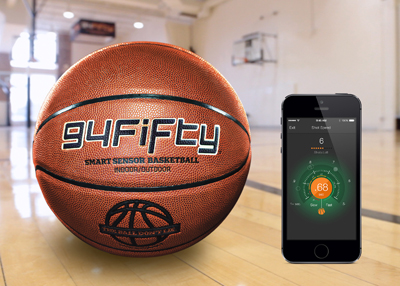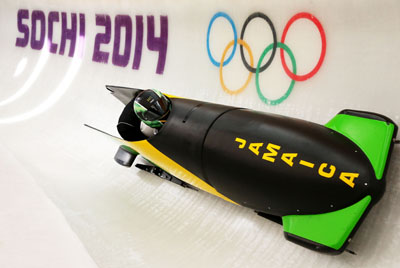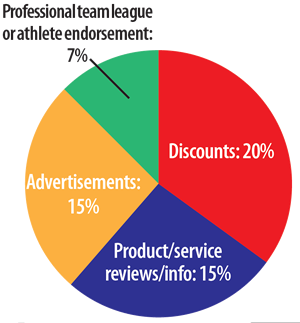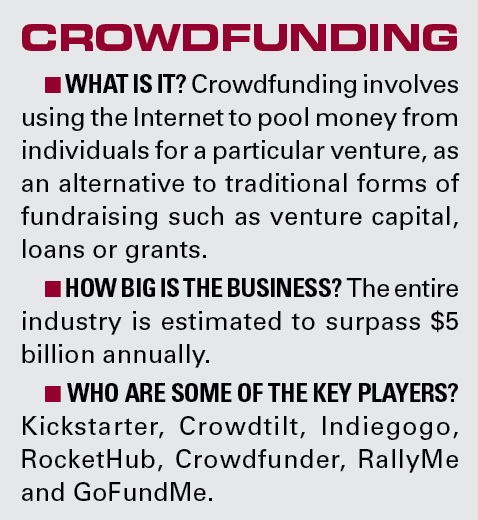Mike Crowley, chief executive of Ohio-based InfoMotion Sports Technologies, had seed money for his company. But what he needed was a little extra cash to bring his new, sensor-embedded basketball to market, and more importantly, a more dynamic way to tell his story.
Enter Kickstarter, a popular crowdfunding platform.
Crowley and InfoMotion, makers of the 94Fifty basketball that yields advanced performance analytics, used Kickstarter last year to raise money for final development of the high-tech product and certification of a companion mobile application to the ball.
 |
InfoMotion Sports Technologies used crowdfunding to raise money and generate buzz for the company’s sensor-embedded basketball.
Photo by: InfoMotion Sports Technologies |
Given the company had raised several rounds of venture capital funding, including a $3.5 million Series A round last year, it may have seemed odd to be asking the public for $100,000 in increments as small as $15.
But there was more to the story. InfoMotion raised $130,237, far exceeding its Kickstarter goal. And critically to the company, the campaign set in motion a groundswell of mainstream attention that helped earn 94Fifty a listing within the iTunes App Store, numerous national media placements, and a prominent spot within January’s International Consumer Electronics Show.
“For us, Kickstarter wasn’t strictly an alternative to VC money, but also a way to help tell the story of our product to the public,” Crowley said of his basketball that carries a $295 retail price. “This is a really sophisticated product, and we often get lumped in with wearables and a lot of other new products not really related to us.
“So much of the wearables market is about counting things, quantitative analysis. What we’re really about is the qualitative analysis, the quality of your practice, and that story was tough to tell a year ago before we got to Kickstarter,” he said.
Initially popular in filmmaking and other creative circles, crowdfunding involves using the Internet to pool money
from individuals for a particular venture, providing a level of speed and immediacy not possible in other forms of fundraising such as venture capital, loans or grants.
The concept has received its largest amount of attention from Hollywood projects such as a forthcoming movie of the cult favorite TV series “Veronica Mars” that raised $5.7 million on Kickstarter. But over the past year, the sports industry has increasingly looked to crowdfunding platforms to fund projects ranging widely from sports equipment to books, video games, websites, and even the Jamaican bobsled team.
After an unlikely qualifying in the two-man bobsled competition for the recently concluded Winter Olympics in Sochi, Russia, the Jamaican delegation was short of funds to cover travel and equipment costs to make the trip.
Lincoln Wheeler, a Washington, D.C.-based fan, began a crowdfunding campaign on Crowdtilt, another prominent platform, that quickly caught fire. The effort soon was transitioned over to the Jamaican team itself, and the campaign ultimately raised nearly $130,000 in three days, far more than its initial goal of $80,000.
“You have a situation here where a fan is directly helping an athlete reach their goal,” said James Beshara, Crowdtilt chief executive and co-founder. “In my view, that’s a lot more singularly impactful than a fan just buying a ticket or a jersey. Yes, I know, the Jamaicans finished last in Sochi. But the competitive dynamic was directly changed by fans that allowed them to be there. I’m still just in awe of that. So yeah, there’s no question sports is more of a focus point for us going forward.”
 |
Crowdfunding gave the Jamaican bobsled team the money it needed to travel to the Winter Olympics.
Photo by: Getty Images |
The Jamaican bobsled team wasn’t the only Olympic-oriented entity to look to crowdfunding to help defray the expenses of competition. Several American speedskaters took to various platforms to raise money to compete in Sochi, with Emily Scott raising $49,000 on her own using GoFundMe.com. Similarly, USA Luge last year used Indiegogo, a rival platform, to raise money for Winter Olympics expenses, generating more than $25,000.
“This was designed as a complement to the traditional sponsor revenue model in [national governing bodies],” said Tim McGhee, founder and principal of New Jersey-based MSP Sports and a consultant to USA Luge. “The money was helpful, and what it also did that was very important was open up an ongoing dialogue with luge fans. Very often in Olympic sports, particularly Winter Olympic sports, there’s the peak of fan interest around the Games, and then a big drop-off. But here, there was a data capture and a new set of names with whom USA Luge can now have a dialogue throughout this four-year gap until the next Olympics.”
Other NGBs are similarly looking at crowdfunding vehicles, McGhee said, and he is now aiding development of a similar venture for the China Lacrosse Association, a startup venture aiming to expand lacrosse to that country and send a delegation to compete in the World Lacrosse Championships later this year in Denver.
Another platform, RallyMe, has partnered with six American NGBs, including the U.S. Ski and Snowboard Association and U.S. Speedskating, to help their athletes raise money through crowdfunding.
Numbers alone tell a story about the sharp rise of crowdfunding over the past year, regardless of genre. Kickstarter, for one, in 2013 saw $480 million worth of projects gain funding, roughly equal to its funding total for 2009-12 combined, and the company is soon to pass $1 billion in total commitments over its nearly five-year history.
But Kickstarter is far from alone, and the entire industry is estimated to now surpass $5 billion annually. Among its bevy of competitors are Crowdtilt, Indiegogo, RocketHub, Crowdfunder, RallyMe and GoFundMe, among many others.
The topical focus of the crowdfunding sites vary widely, with some concentrated on creative or artistically oriented projects, while others hold a strict entrepreneurial bent designed to help get new businesses launched. RallyMe holds a similar topical bent and focuses only on athletes, teams and sports-related organizations.
The donation structures also can differ greatly, with some sites like Kickstarter operating on an all-or-nothing model in which users seeking crowdfunds receive the money only if the entire target is met. Other platforms such as Crowdtilt employ a more stratified structure in which a minimum level of funding for success, a “tilt point,” is identified that if met will allow for a release of funds, followed by a total fundraising goal.
The platforms themselves then generate revenue by taking a commission, often around 4 percent, that often increases if projects fail to hit their funding goals, which in turn provides an incentive for success. Donors don’t receive any financial return for their donations but typically receive special perks, such as memorabilia or exclusive content, in addition to helping bring projects to life.
Regardless of the particular donation structure, the presence of crowdfunding has opened a storytelling component to fundraising not possible in other venues.
“The crowdfunding, particularly our all-or-nothing model, really lends a strong narrative arc to the whole thing,” said Justin Kazmark, Kickstarter spokesman. “People get really invested in these projects, emotionally in addition to financially. And often, once funding gets to a certain level, there’s a groundswell from the original donors and it takes on a new momentum.”
Despite the accelerating growth rates for crowdfunding, generally less than half of the projects placed on the various platforms reach their funding goals, and depending on the particular platform, that percentage may be less than 20 percent. Those numbers may soon begin to rise as new predictive models measuring various factors such as social media reception can project with increasing accuracy the chances of ultimate success.
But even recognized names can find crowdfunding not a sure thing. Veteran baseball writer Peter Gammons and partner TruMedia Networks last summer used Indiegogo to help fund the launch of his new website, GammonsDaily.com. The site is up and running, and Indiegogo was far from the sole funding source for the project, but the campaign raised just $6,830 of its $25,000 goal. USA Luge, similarly, reached only half of its $50,000 goal in its campaign last year. Indiegogo allows listing parties to retain all the money they raise, albeit at a higher commission rate. Still, TruMedia Networks President and CEO Rafe Anderson remains bullish on crowdfunding.
“Crowdfunding isn’t merely about raising capital for new ideas. It’s a powerful market research tool,” Anderson said. “Services like Indiegogo and Kickstarter help entrepreneurs vet their concepts and receive valuable insight from their most loyal customers.”
SOCIAL STUDIES: EXAMINING SOCIAL MEDIA HABITS AND ATTITUDES
Navigate Research and Wasserman Media Group surveyed 8,000 fans across seven sports this year to gauge social media habits and attitudes.
Below are some highlights from that study, which is scheduled to be released this week.
| Of the MLS fans surveyed, 32 percent said that social media makes them feel more connected to their favorite sport. |
| MLS |
|
| NHL |
|
| NBA |
|
| MLB |
|
| NFL |
|
| NASCAR |
|
| |
| Brand presence on social media is gaining credibility: 40 percent of sports fans who became aware of a sponsorship via social media are likely to recommend that sponsor’s brand. That compares to 27 percent of those fans who heard about a sports sponsorship through a TV exposure being likely to take the same action. |
| Social Media |
|
| Website (other than social media) |
|
| On-site signage |
|
| Radio |
|
| TV exposure |
|
| |
| Social media influences consumption, as fans are enticed most by discounts offered on social media. |
 |







